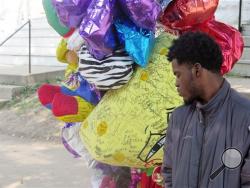MILWAUKEE (AP) — On what would have been his friend's 18th birthday, a solemn teenager stared at a slumping display of helium balloons and a giant stuffed doll tied to a tree.
The decorations had been up for weeks as a memorial to Breanna Eskridge, who was gunned down outside her grandmother's Milwaukee home. Jamel Russell came this day to mourn.
Such improvised tributes are part of the landscape in tough neighborhoods across the U.S., symbolizing a complex knot of emotions that community activists and city officials must navigate as they grapple with whether to remove them. To some, they're eyesores, reminders of gang disputes, drug sales and sadness. To others, they're an important acknowledgment of loss and mourning.
In Milwaukee, victims' advocates are leading a push to make these ad hoc memorials into something more lasting. Community organizer Camille Mays has been working with local officials to establish publicly funded individual tributes to replace the makeshift shrines.
"Something that can promote life and growth and peace," she said.
Collective tributes to victims of gun violence are fairly common. Boston has established a peace garden to memorialize its homicide victims, and Dayton, Ohio, for the past quarter-century has dedicated one day a year to honor the people lost to violence there.
But Rhonda Barner, who has worked as a survivors' advocate for decades, said she knows of no city that does what Milwaukee is considering by honoring homicide victims with individual memorials. The closest match she has found is in Florida, where road markers recognize certain traffic deaths with an inscription bearing a victim's name.
Mays' plan would be particularly visible around Milwaukee's north side, where unemployment is rampant and residents push back against gangs and drugs.
Support has been widespread, but some, including Selvie Penix, are conflicted.
"It would be all right, I guess," Penix said, standing in front of a crucifix, stuffed dog and red rose placed on a tree where his sister, Tracey Howard, was killed weeks ago. "It would be sentimental to some people. For me, it would just bring me back to seeing her laying down."
Alderman Russell Stamper says there is enough support among city leaders to get funding approved for Mays' cause.
Stamper helped establish a lasting tribute to Russell "Tattoo Russ" Setum, who was killed after celebrating his 24th birthday in 2012 by a shooter who said "sorry, mama," as he pulled the trigger while she pleaded for her son's life.
Friends tied the typical decorations to a tree outside the Setum family home where he was killed, but his mother, Leona Setum, took it all down. Today, a modest bouquet of plastic roses, hidden inside landscaping, marks the spot at the base of the tree.
A few blocks away sits a garden with a hand-painted sign reading "Uptown Community Gardens of Peace, featuring Russell Setum's cherry tree."
Stamper says the city has tens of thousands of dollars set aside each year for lot enhancements and community gardens. For him, it's an easy step to transition teddy bear shrines into these sorts of tributes.
Mays likes this concept but would be satisfied with something less elaborate: a small plant, plaque or sign, simply marking the location, even if it doesn't include the name of the person killed.
Police Capt. Jason Smith, who runs a north side district singled out for excellence in "problem-oriented policing," said when it comes to temporary tributes, he "used to be a jerk and take them down." He now sees them as a worthwhile part of mourning and an opportunity for developing relationships that improve police work.
The sites are flashpoints for anger, which can lead to retaliation killings, so Smith has instructed his officers to call a group of pastors after shootings where memorials spring up. At the top of that list is a man who helped train him, Malcom Hunt, who went into ministry after retiring from the force.
Hunt says the memorials are places where he can reach out to people to keep their minds on healing and off revenge.
He gave his card, recently, to the 17-year-old who was thinking of Breanna Eskridge.
Her balloons were beginning to sag. The oversized SpongeBob doll was weathered and fading, as were the hand-written messages — including "R.I.P.," ''I love you," and "love always" — scrawled across it.
It wasn't his first encounter with loss. Russell had the image of another tribute saved in his cellphone, this one affixed to a lamp post a few blocks away for his younger brother, Japhet Moore, who was 14 when he was killed two years ago.
Russell said he visits the displays all the time. If they were permanent, he said, "that would be a good thing."

